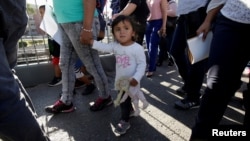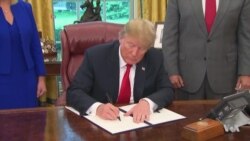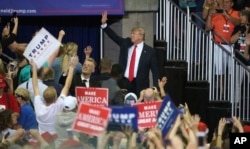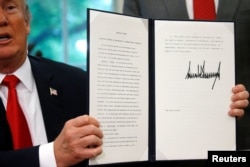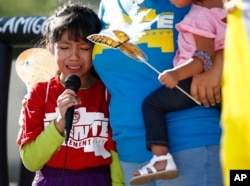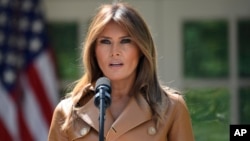A day after U.S. President Donald Trump reversed a policy of separating migrant families at the U.S.-Mexico border, the House of Representatives is set to vote Thursday on a pair of immigration bills that address the separations as well as other issues that have divided the country’s major political parties.
The outcome of the votes is uncertain. One measure is more hard-line, while the other represents a compromise between the Republican Party’s conservative and moderate wings.
The compromise bill includes a provision requiring children and their parents to be detained together if they cross the border illegally. It would also provide $25 billion in funding for Trump’s much-promised border wall, change the existing visa lottery into a merit-based system and provide a path to citizenship for the young undocumented immigrants who came to the United States as children.
WATCH: Trump Reverses Migrant Separation Policy
Republicans control Congress
Republicans hold a majority in both houses of Congress. Party leaders, including President Trump and House Speaker Paul Ryan, have lobbied lawmakers this week in hopes of securing their support for the legislation.
“We can enforce our immigration laws without breaking families apart,” Ryan said Wednesday before Trump announced he would sign an executive order to end breaking up families.
The president’s policy retreat followed a withering attack by Republican and Democratic officials who characterized the family separations as inhumane. The actions left parents with little or no information about where their children were being taken or when or how they would be reunited.
“It’s about keeping families together while at the same time making sure that we have a very powerful, very strong border,” Trump said as he signed the document just before departing the White House for a political rally in the state of Minnesota.
Later, at the political rally, the president defended his position saying the executive order he signed hours earlier would not weaken his border strategy:
“The border is going to be just as tough as it’s been” despite the executive order, he said.
Trump’s executive order went into effect immediately when he signed it, according to Gene Hamilton, counselor to U.S. Attorney General Jeff Sessions. However, he added, there will be an “implementation phase that follows.”
“Right now we have the lawful authority to detain a family unit together for up to 20 days,” Hamilton told reporters on a conference call following the signing of the order. But for extended detentions to keep families together beyond that timeframe it is “critically important” for Judge Dolly Gee of the U.S. District Court of Central California to make a ruling, according to Hamilton.
Custody of families
Under the order, the Homeland Security secretary will, with some exceptions, maintain custody of immigrant families while any legal proceedings concerning illegal entry or immigration status involving their members are pending implementation. It also instructs the Defense Department to provide or construct facilities to house the families. The Justice Department is ordered, “to the extent practicable,” to “prioritize the adjudication of cases involving detained families.”
The order also directs the Justice Department to seek a modification of a court order to permit families that enter the United States illegally to be detained together until their criminal proceedings are concluded.
The president emphasized that his administration’s overall “zero-tolerance” policy on illegal immigration is not ending.
For days, Trump and key officials in his administration had contended that he could not act unilaterally to overturn the policy and that only Congress, through legislation, could ban the break-up of families.
The U.S. in the last six weeks has separated more than 2,300 young children from their parents and sent them to detention centers, while charging their parents with illegally entering the country.
Wave of criticism
Business and religious leaders, four former U.S. first ladies and Trump’s wife, Melania Trump, also voiced sharp criticism of the policy to split up migrant families, many of them escaping poverty and turmoil in Central America, as they illegally crossed the U.S. border.
The executive order is likely to quell some, but not all of the criticism.
“An eleventh-hour executive order doesn’t fix the harm done to thousands of children and their parents,” said a statement from the American Civil Liberties Union. “Trump’s order replaces one crisis for another: children don’t belong in jail at all, even with their parents, under any circumstances.”
Trump, earlier Wednesday, told a group of lawmakers at the White House that the images of sobbing and frightened young children being taken away from their parent by U.S. authorities “affect everybody.” The president added that he was torn by the issue.
“We want the heart,” he said, “but we also want strong borders and we want no crime.”
Trump also renewed his attacks on the media and opposition Democrats for the way they were portraying his administration’s policy.
The U.S. leader contended that the mainstream U.S. news outlets are “not mentioning the safety and security of our country when talking about illegal immigration.” He claimed that U.S. immigration laws “are the weakest and worst anywhere in the world” and that Democrats “will do anything not to change them.”
“It’s the Democrats fault, they won’t give us the votes needed to pass good immigration legislation,” Trump said, ignoring that Republicans control both chambers of Congress. “They want open borders, which breeds horrible crime. Republicans want security. But I am working on something — it never ends!”
The Associated Press reported Tuesday that the Trump administration has been sending babies and other young children separated from their parents at the border to at least three “tender age” shelters in South Texas, and that the government plans to open another shelter to house hundreds of young migrants in Houston.
Lawyers and medical providers who have visited the shelters described play rooms with crying preschool-age children in crisis, according to AP.




